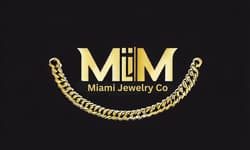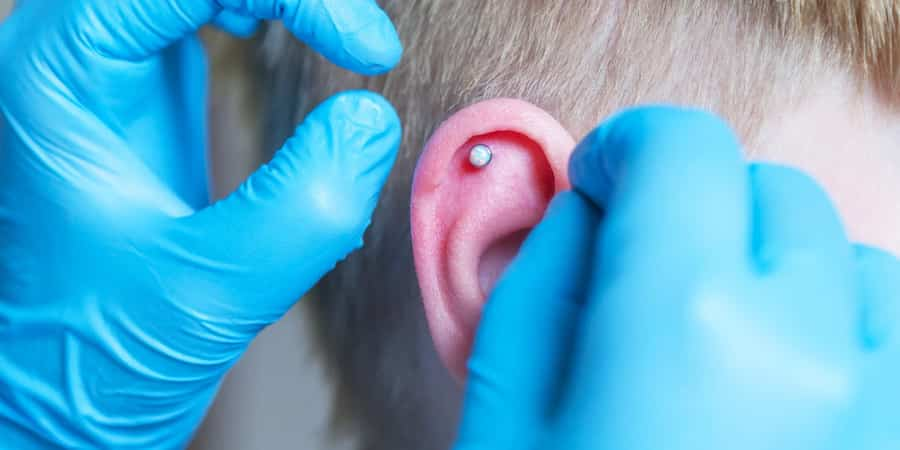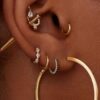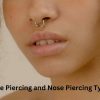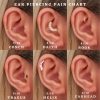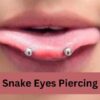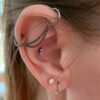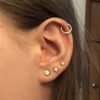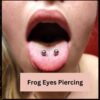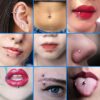Ear Piercing
Ear Piercing on Guys and Popular Ear Piercing Types For Men
Ear piercing is a popular form of body modification that involves making a hole in the earlobe or other parts of the ear and inserting a piece of jewelry. Ear piercing has been practiced by various cultures and civilizations for thousands of years, and it can have different meanings and purposes depending on the context. For men, ear piercing can be a way of expressing their personality, style, identity, or rebellion.
However, ear piercing is not as simple as it may seem. There are many factors to consider before getting your ears pierced, such as the type, location, size, shape, and material of the jewelry, the method and hygiene of the piercing, the healing and aftercare process, the risks and complications, and the cost and maintenance.
In this article, I will provide you with a complete guide on everything you need to know about ear piercing for guys so that you can make an informed decision and enjoy your new look.
- Related: Ear piercings for Guys Left or Right
Contents
- 1 Why Should You Get Your Ears Pierced?
- 2 What Are the Different Types of Ear Piercings For Guys?
- 3 What Are the Different Types of Jewelry For Guys?
- 4 How Should You Get Your Ears Pierced?
- 5 How Should You Heal and Care for Your Ear Piercings?
- 6 What Are the Risks and Complications of Ear Piercing?
- 7 How Much Does Ear Piercing Cost?
- 8 Conclusion
- 9 FAQs
Why Should You Get Your Ears Pierced?
The first question you may ask yourself is why you should get your ears pierced in the first place.
There is no definitive answer to this question, as different people may have different reasons and motivations for piercing their ears.
However, some of the common benefits of ear piercing for men are:
- It can enhance your appearance and attractiveness. Ear piercing can add some flair and edge to your look, and make you stand out from the crowd. You can choose from a variety of jewelry styles and colors to match your outfit, mood, or occasion.
- It can express your individuality and creativity. Ear piercing can be a way of showing your personality, interests, values, or beliefs. You can choose from different types of piercings, such as lobe, helix, tragus, conch, daith, rook, industrial, or orbital, to create a unique and distinctive look.
- It can boost your confidence and self-esteem. Ear piercing can make you feel more comfortable and proud of your body and appearance. It can also give you a sense of achievement and satisfaction when you overcome the pain and fear of getting pierced.
- It can connect you with other people and cultures. Ear piercing can be a way of joining a community or subculture that shares your passion for body modification. It can also help you learn more about the history and meaning of ear piercing in different cultures and traditions.
What Are the Different Types of Ear Piercings For Guys?
The next thing you need to know is what are the different types of ear piercings that you can choose from. The type of ear piercing refers to the location and direction of the hole in the ear. There are many types of ear piercings, but here are some of the most common ones for men:
Lobe piercing:
This is the most basic and common type of ear piercing, where the hole is made in the lower part of the earlobe. This type of piercing is usually painless and easy to heal, and it can accommodate a wide range of jewelry styles and sizes.
Helix piercing:
This is a type of cartilage piercing, where the hole is made in the upper part of the outer rim of the ear. This type of piercing is more painful and difficult to heal than lobe piercing, but it can create a cool and trendy look. You can have one or more helix piercings on one or both ears.
Tragus piercing:
This is another type of cartilage piercing, where the hole is made in the small flap of cartilage that covers the entrance to the ear canal. This type of piercing is also more painful and difficult to heal than lobe piercing, but it can add some subtle and stylish flair to your look. You can have one tragus piercing on one or both ears.
Conch piercing:
This is yet another type of cartilage piercing, where the hole is made in the inner or outer part of the curved area of the ear that resembles a conch shell. This type of piercing is also more painful and difficult to heal than lobe piercing, but it can create a bold and striking look. You can have one conch piercing on one or both ears.
Daith piercing:
This is a type of cartilage piercing that is similar to tragus piercing, but the hole is made in the innermost part of the cartilage that forms a fold above the ear canal. This type of piercing is also more painful and difficult to heal than lobe piercing, but it can create a unique and elegant look. You can have one daith piercing on one or both ears.
Rook piercing:
This is another type of cartilage piercing that is similar to daith piercing, but the hole is made in the upper part of the cartilage that forms a fold above the ear canal. This type of piercing is also more painful and difficult to heal than lobe piercing, but it can create a sophisticated and classy look. You can have one rook piercing on one or both ears.
Industrial piercing:
This is a type of cartilage piercing that involves two holes in the upper part of the outer rim of the ear, connected by a single piece of jewelry, usually a barbell. This type of piercing is more painful and difficult to heal than lobe piercing, but it can create a dramatic and edgy look. You can have one industrial piercing on one or both ears.
Orbital piercing:
This is a type of cartilage piercing that involves two holes in any part of the ear, connected by a single piece of jewelry, usually a ring. This type of piercing is more painful and difficult to heal than lobe piercing, but it can create a fun and funky look. You can have one orbital piercing on one or both ears.
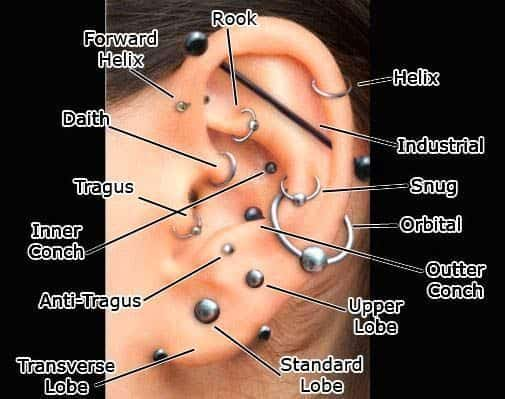
What Are the Different Types of Jewelry For Guys?
The next thing you need to know is what are the different types of jewelry that you can wear in your ear piercings. The type of jewelry refers to the shape, size, material, and design of the piece of metal or other material that you insert in the hole in your ear.
There are many types of jewelry, but here are some of the most common ones for men:
Stud:
This is a type of jewelry that consists of a small ball or gem that sits on the front of the ear, and a post that goes through the hole and secures with a backing on the back of the ear. This type of jewelry is simple and versatile, and it can suit any type of ear piercing.
Hoop:
This is a type of jewelry that consists of a circular ring that goes through the hole and closes with a clasp or hinge on the back of the ear. This type of jewelry is classic and stylish, and it can suit any type of ear piercing.
Barbell:
This is a type of jewelry that consists of a straight or curved bar that goes through the hole and has a ball or gem on each end. This type of jewelry is modern and trendy, and it can suit any type of ear piercing, especially industrial piercing.
Horseshoe:
This is a type of jewelry that consists of a curved bar that goes through the hole and has a ball or gem on each end. This type of jewelry is similar to a barbell, but it has more curvature and flexibility. It can suit any type of ear piercing, especially orbital piercing.
Spiral:
This is a type of jewelry that consists of a twisted bar that goes through the hole and has a ball or gem on each end. This type of jewelry is similar to a horseshoe, but it has more twists and turns. It can suit any type of ear piercing, especially helix or conch piercing.
Plug:
This is a type of jewelry that consists of a cylindrical piece that goes through the hole and has a flared end on each side. This type of jewelry is used to stretch and enlarge the hole in the earlobe, and it can create a bold and daring look. It can only suit lobe piercing.
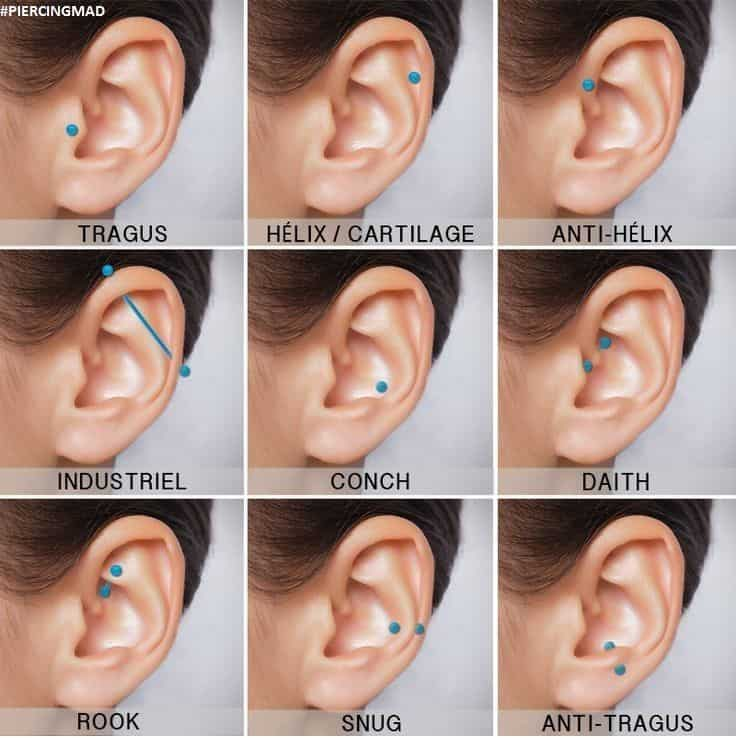
How Should You Get Your Ears Pierced?
The next thing you need to know is how you should get your ears pierced. The method of ear piercing refers to the technique and tool used to make the hole in your ear.
There are two main methods of ear piercing: needle piercing and gun piercing.
Needle piercing:
This is a method where a hollow needle is used to puncture the ear and create a hole for the jewelry. This method is performed by a professional piercer in a sterile environment, using gloves, antiseptic, and disposable needles. This method is more precise, safe, hygienic, and less painful than gun piercing, and it can be used for any type of ear piercing.
Gun piercing:
This is a method where a spring-loaded device is used to push a stud through the ear and create a hole for the jewelry. This method is performed by an amateur piercer in an unsterile environment, using reusable guns and studs. This method is less precise, safe, hygienic, and more painful than needle piercing, and it can only be used for lobe piercing.
How Should You Heal and Care for Your Ear Piercings?
The fifth thing you need to know is how you should heal and care for your ear piercings after getting them done. The healing and aftercare process refers to the steps you need to take to ensure that your piercings heal properly and avoid infection or other complications. The healing time varies depending on the type of ear piercing, but it generally ranges from 6 weeks to 6 months for lobe piercing, and from 3 months to 1 year for cartilage piercing.
The aftercare steps are:
- Clean your piercings twice a day with a saline solution or an antiseptic spray. Avoid using alcohol, hydrogen peroxide, or harsh soap, as they can irritate and dry out your skin.
- Gently rotate your jewelry once a day to prevent it from sticking to your skin. Avoid touching, twisting, or pulling your jewelry unnecessarily, as this can delay the healing and cause infection.
- Change your pillowcase and towel regularly to avoid bacteria and dirt buildup. Avoid sleeping on the side of your pierced ear, as this can cause pressure and pain.
- Avoid swimming, sauna, or hot tubs until your piercings are fully healed, as they can expose your piercings to harmful chemicals and bacteria. If you have to swim, cover your piercings with a waterproof bandage or earplug.
- Avoid wearing tight or heavy clothing, hats, helmets, headphones, or earphones that can rub or snag on your piercings. Wear loose and comfortable clothing and accessories that can protect your piercings from injury.
- Avoid changing your jewelry until your piercings are fully healed, as this can irritate and reopen the wound. Stick to the jewelry that you were pierced with, and choose hypoallergenic materials such as titanium, surgical steel, gold, or silver.

What Are the Risks and Complications of Ear Piercing?
Ear piercing is generally safe and harmless if done properly and cared for well, but it can also pose some potential problems such as:
Infection:
This is the most common complication of ear piercing, where the pierced area becomes red, swollen, painful, warm, or oozing pus. Infection can be caused by poor hygiene, improper technique, low-quality jewelry, or allergic reactions. Infection can be treated by cleaning the piercing regularly, applying topical antibiotics, or removing the jewelry if necessary. In severe cases, infection can spread to other parts of the ear or body and cause serious damage.
Allergic reaction:
This is another common complication of ear piercing, where the pierced area becomes itchy, rashy, blistered, or inflamed. Allergic reactions can be caused by sensitivity to the material or coating of the jewelry. Allergic reaction can be treated by switching to a different type of jewelry that is more suitable for your skin type, such as titanium or gold.
Scarring:
This is a possible complication of ear piercing, where the pierced area develops a raised or thickened scar tissue that may affect the appearance or function of the ear. Scarring can be caused by trauma, infection, inflammation, or genetics. Scarring can be prevented by avoiding excessive pressure or friction on the piercing, and by using silicone gel or cream to soften and flatten the scar tissue.
Migration:
This is a rare complication of ear piercing, where the jewelry moves from its original position and creates a new hole in the ear. Migration can be caused by poor technique, low-quality jewelry, infection, inflammation, or rejection. Migration can be prevented by choosing a reputable piercer who uses proper tools and techniques, and by wearing appropriate jewelry that fits well and does not pull on the piercing.
Rejection:
This is another rare complication of ear piercing, where the body rejects the foreign object and pushes it out of the skin. Rejection can be caused by poor technique, low-quality jewelry, infection, inflammation, or genetics. Rejection can be prevented by choosing a reputable piercer who uses proper tools and techniques, and by wearing appropriate jewelry that fits well and does not irritate the skin.

How Much Does Ear Piercing Cost?
The last thing you need to know is how much ear piercing costs. The cost of ear piercing depends on various factors, such as the type of ear piercing, the type of jewelry, the method of piercing, the location and reputation of the piercer, and the aftercare products. The cost of men’s ear piercing can range from $10 to $100 or more per ear.
Here are some average prices for different types of ear piercings for guys:
- Lobe piercing: $10 to $50 per ear
- Helix piercing: $20 to $60 per ear
- Tragus piercing: $30 to $70 per ear
- Conch piercing: $40 to $80 per ear
- Daith piercing: $50 to $90 per ear
- Rook piercing: $60 to $100 per ear
- Industrial piercing: $70 to $110 per ear
- Orbital piercing: $80 to $120 per ear
These prices are only estimates and may vary depending on your location and choice of piercer and jewelry. You should also factor in the cost of the aftercare products, such as saline solution, antiseptic spray, or silicone gel, which can add another $10 to $20 to your total cost. You should also tip your piercer at least 15% to 20% of the service fee, as a sign of appreciation and gratitude.
Conclusion
Ear piercing is a great way to enhance your appearance, express your individuality, boost your confidence, and connect with other people and cultures. However, ear piercing also requires careful consideration and preparation, as it involves making a permanent change to your body and exposing it to potential risks and complications. Therefore, before you get your ears pierced, you should know everything about ear piercing for men, such as the benefits, types, jewelry, methods, aftercare, risks, and costs. By doing so, you can make an informed decision and enjoy your new look.
FAQs
Here are some frequently asked questions about ear piercing for men:
How do I know if my ear piercing is infected?
Some signs of infection are redness, swelling, pain, warmth, pus, or fever. If you notice any of these symptoms, you should contact your piercer or doctor immediately and follow their instructions.
How long do I have to wait before I can change my jewelry?
You should wait until your piercings are fully healed before you change your jewelry. This can take from 6 weeks to 1 year depending on the type of ear piercing. Changing your jewelry too soon can cause irritation and infection.
Can I take out my jewelry for a while and put it back in later?
You should not take out your jewelry for a long time unless you want your piercings to close up. The hole in your ear can shrink or close within hours or days depending on how old your piercings are. If you have to take out your jewelry for some reason, you should put it back in as soon as possible or use a retainer to keep the hole open.
Can I get my ears pierced if I have allergies or medical conditions?
You should consult with your doctor before you get your ears pierced if you have any allergies or medical conditions that may affect your healing or increase your risk of complications. For example, if you have diabetes, blood disorders, heart problems, or immune system disorders, you may need to take extra precautions or avoid ear piercing altogether.
Can I get my ears pierced more than once?
Yes, you can get your ears pierced more than once as long as you have enough space and healthy tissue in your ears. You can also get different types of piercings in different parts of your ears. However, you should not get too many piercings at once or in a short period of time, as this can overload your body and impair your healing. You should also make sure that your existing piercings are fully healed before you get new ones.

Camila Luna is a passionate jewelry enthusiast and content creator at Miami Jewelry Co. With a focus on providing high-quality, Miami-style jewelry, Camila and her team specialize in a wide range of jewelry that includes bracelets, necklaces, earrings, and more
